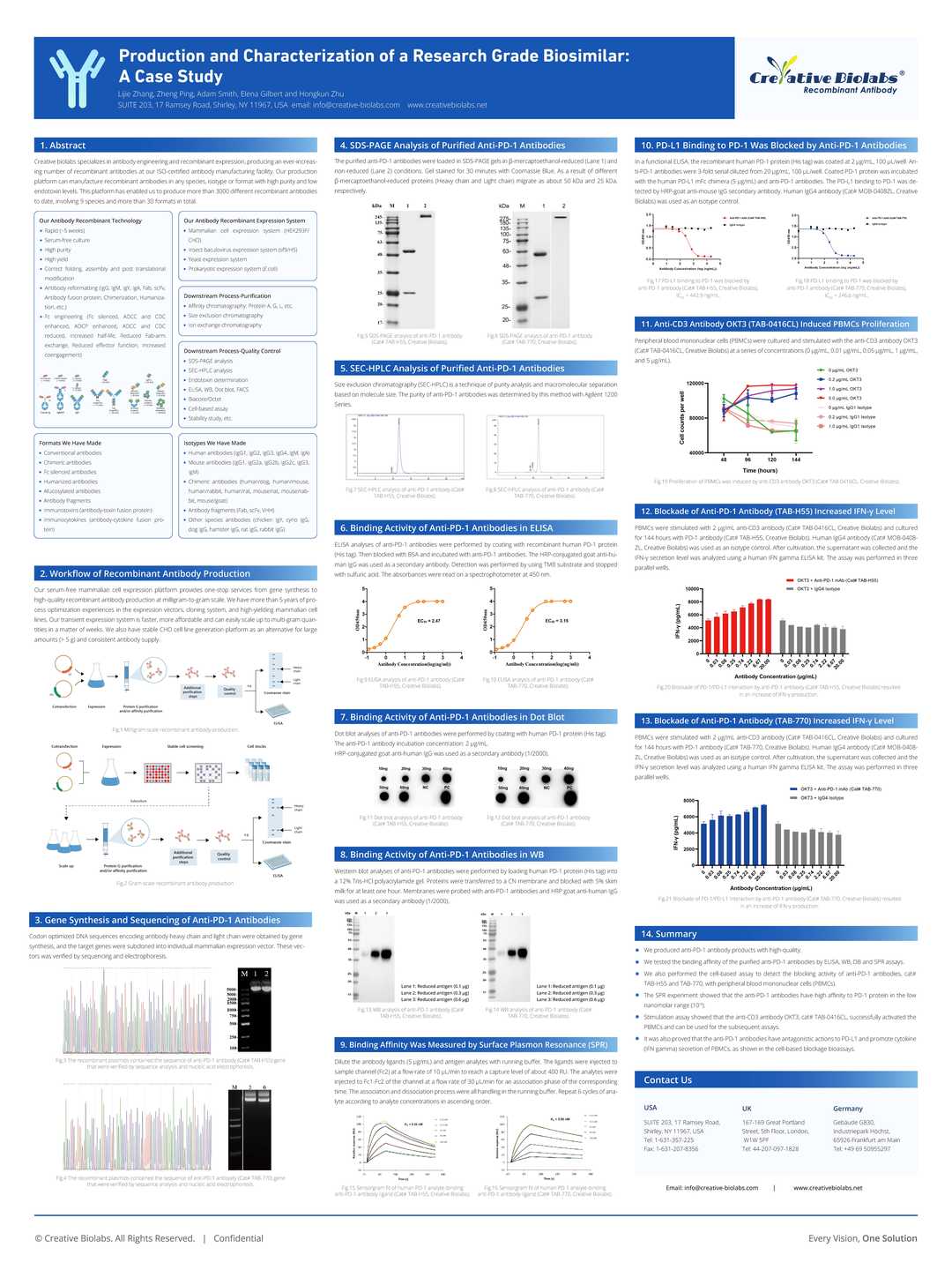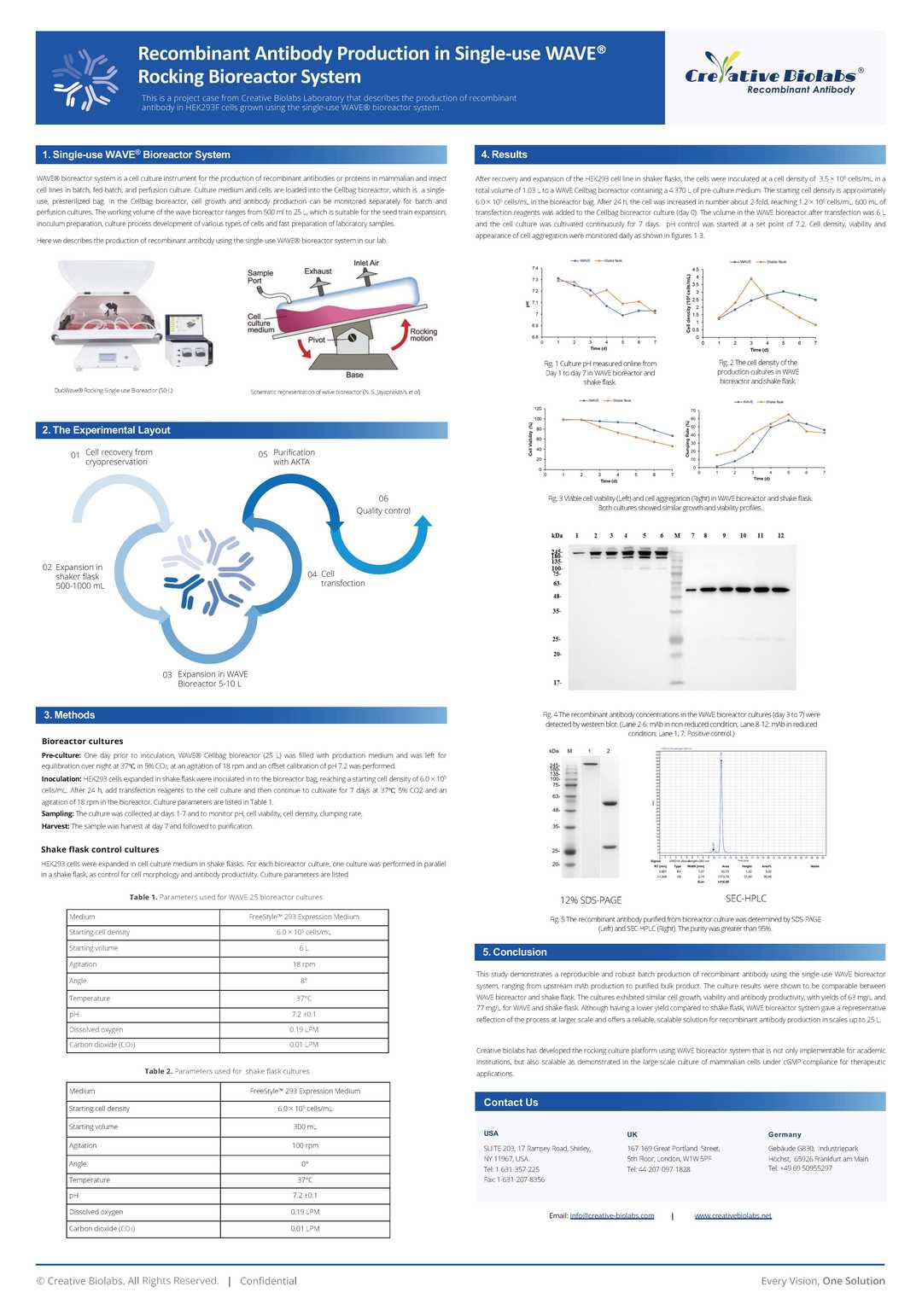Anti-PDCD1 Recombinant Antibody (TAB-770)
CAT#: TAB-770
Recombinant human monoclonal antibody expressed in CHO binding to human PDCD1. It is a fully human IgG4 monoclonal antibody for the treatment of cancer. It acts as an immunomodulator by blocking ligand activation of the programmed cell death 1 (PD-1) receptor on activated T cells.













Specifications
- Immunogen
- The details of the immunogen for this antibody are not available.
- Host Species
- Human
- Derivation
- Human
- Type
- IgG4 - kappa
- Species Reactivity
- Human
- Applications
- IF, IP, Neut, FuncS, ELISA, FC, ICC
- MW
- 143.6 kDa
- Related Disease
- Cancers
Product Property
- Purity
- >97%, by SDS-PAGE under reducing conditions and visualized by silver stain.
- Storage
- Store it under sterile conditions at -20°C upon receiving. Recommend to pack the protein into smaller quantities for optimal storage.
Applications
- Application Notes
- The PDCD1 antibody has been reported in applications of IHC, ELISA, ADCC, IF, Stim.
ELISA: CD4+ T cells (1 × 105) and allogeneic DCs (1 × 104) were cocultured with or without dose titrations of TAB-770 added at the initiation of the assay. After 5 days, IFNγ secretion in culture supernatants was analyzed by ELISA, and cells were labeled with 3H-thymidine for an additional 18 hours to measure T-cell proliferation.
Target
Customer Review
There are currently no Customer reviews or questions for TAB-770. Click the button above to contact us or submit your feedback about this product.


Q&As
-
How effective is it for PDCD1 pathways?
A: The Anti-PDCD1 Recombinant Antibody (TAB-770) is highly effective for investigations into PDCD1 pathways. Its specificity allows detailed exploration of immune responses, providing dependable outcomes in studies focusing on immune checkpoint inhibitors and their roles in disease modulation.
-
Where does it show specificity?
A: The TAB-770 antibody displays strong specificity for PDCD1, an aspect that enhances its utility in immunological assays. In research, it serves as a crucial element for validating PDCD1 presence, thereby assisting in elucidating its regulatory roles in different immune-mediated processes and therapeutic studies.
View the frequently asked questions answered by Creative Biolabs Support.
Cite This Product
To accurately reference this product in your publication, please use the following citation information:
(Creative Biolabs Cat# TAB-770, RRID: AB_3112008)
Submit Your Publication
Published with our product? Submit your paper and receive a 10% discount on your next order! Share your research to earn exclusive rewards.
Biosimilar Overview
Please refer to TAB-770 Overview to learn more about the mechanism of action, clinical projects, and approved drugs of TAB-770.
Downloadable Resources
Download resources about recombinant antibody development and antibody engineering to boost your research.
Product Notes
This is a product of Creative Biolabs' Hi-Affi™ recombinant antibody portfolio, which has several benefits including:
• Increased sensitivity
• Confirmed specificity
• High repeatability
• Excellent batch-to-batch consistency
• Sustainable supply
• Animal-free production
See more details about Hi-Affi™ recombinant antibody benefits.
Datasheet
MSDS
COA
Certificate of Analysis LookupTo download a Certificate of Analysis, please enter a lot number in the search box below. Note: Certificate of Analysis not available for kit components.
Protocol & Troubleshooting
We have outlined the assay protocols, covering reagents, solutions, procedures, and troubleshooting tips for common issues in order to better assist clients in conducting experiments with our products. View the full list of Protocol & Troubleshooting.
See other products for "PDCD1"
Select a product category from the dropdown menu below to view related products.
| CAT | Product Name | Application | Type |
|---|---|---|---|
| MOB-1201z | Mouse Anti-PDCD1 Recombinant Antibody (clone 27G11) | ELISA, FC, ICC, IF, IHC | Mouse IgG1 |
| CAT | Product Name | Application | Type |
|---|---|---|---|
| TAB-900 | Anti-Human PD-1/PDCD1/CD279 Recombinant Antibody (TAB-900) | IP, IF, FuncS, FC, Neut, ELISA, ICC | IgG1 - kappa |
| CAT | Product Name | Application | Type |
|---|---|---|---|
| TAB-H55 | Human Anti-PDCD1 Recombinant Antibody (TAB-H55) | Inhib, Agonist | IgG4, κ |
| CAT | Product Name | Application | Type |
|---|---|---|---|
| PABL-295 | Human Anti-PDCD1 Recombinant Antibody (clone CBL12Q) | WB, ELISA, FuncS | Human IgG4 kappa |
| CAT | Product Name | Application | Type |
|---|---|---|---|
| PSBL-295 | Human Anti-PDCD1 Recombinant Antibody (clone CBL42Q); scFv Fragment | WB, ELISA, FuncS | Human scFv |
| CAT | Product Name | Application | Type |
|---|---|---|---|
| PFBL-295 | Human Anti-PDCD1 Recombinant Antibody (clone CBL27Q); Fab Fragment | WB, ELISA, FuncS | Human Fab |
| CAT | Product Name | Application | Type |
|---|---|---|---|
| TAB-0961CL | Anti-Human PDCD1 Recombinant Antibody (PD1-17) | ELISA, FuncS | Human antibody |
| CAT | Product Name | Application | Type |
|---|---|---|---|
| TAB-0962CL | Anti-Mouse Pdcd1 Recombinant Antibody (PD1-F2) | ELISA | Human antibody |
| CAT | Product Name | Application | Type |
|---|---|---|---|
| TAB-0963CL | Mouse Anti-PDCD1 Recombinant Antibody (TAB-0963CL) | FC | Mouse IgG |
| CAT | Product Name | Application | Type |
|---|---|---|---|
| TAB-0964CL | Mouse Anti-PDCD1 Recombinant Antibody (TAB-0964CL) | ELISA, Inhib | Mouse IgG |
| CAT | Product Name | Application | Type |
|---|---|---|---|
| TAB-0965CL | Mouse Anti-PDCD1 Recombinant Antibody (TAB-0965CL) | ELISA | Mouse IgG |
| CAT | Product Name | Application | Type |
|---|---|---|---|
| TAB-0966CL | Human Anti-PDCD1 Recombinant Antibody (TAB-0966CL) | ELISA | Humanized antibody |
| CAT | Product Name | Application | Type |
|---|---|---|---|
| TAB-0967CL | Anti-Human PDCD1 Recombinant Antibody (AB7) | ELISA, WB |
| CAT | Product Name | Application | Type |
|---|---|---|---|
| TAB-0968CL | Anti-Human PDCD1 Recombinant Antibody (cAB7) | ELISA, WB | Chimeric antibody (mouse/human) |
| CAT | Product Name | Application | Type |
|---|---|---|---|
| TAB-0969CL | Mouse Anti-PDCD1 Recombinant Antibody (TAB-0969CL) | FC, ELISA | Mouse IgG |
| CAT | Product Name | Application | Type |
|---|---|---|---|
| TAB-0970CL | Human Anti-PDCD1 Recombinant Antibody (TAB-0970CL) | ELISA, FuncS | Human IgG1 |
| CAT | Product Name | Application | Type |
|---|---|---|---|
| TAB-0971CL | Human Anti-PDCD1 Recombinant Antibody (TAB-0971CL) | ELISA | Human IgG |
| CAT | Product Name | Application | Type |
|---|---|---|---|
| TAB-0972CL | Human Anti-PDCD1 Recombinant Antibody (TAB-0972CL) | ELISA | Human IgG |
| CAT | Product Name | Application | Type |
|---|---|---|---|
| TAB-0974CL | Human Anti-PDCD1 Recombinant Antibody (TAB-0974CL) | ELISA | Chimeric (Mouse/Human) antibody |
| CAT | Product Name | Application | Type |
|---|---|---|---|
| TAB-0975CL | Human Anti-PDCD1 Recombinant Antibody (TAB-0975CL) | ELISA | Humanized antibody |
| CAT | Product Name | Application | Type |
|---|---|---|---|
| TAB-0977CL | Anti-Human PDCD1 Recombinant Antibody (949gH1a) | FC | Humanized antibody |
| CAT | Product Name | Application | Type |
|---|---|---|---|
| TAB-0968CL-S(P) | Anti-Human PDCD1 Recombinant Antibody scFv Fragment (cAB7) | ELISA, WB | Chimeric antibody (mouse/human) |
| CAT | Product Name | Application | Type |
|---|---|---|---|
| TAB-0974CL-S(P) | Human Anti-PDCD1 Recombinant Antibody; scFv Fragment (TAB-0974CL-S(P)) | ELISA | Human scFv |
| CAT | Product Name | Application | Type |
|---|---|---|---|
| TAB-0968CL-F(E) | Anti-Human PDCD1 Recombinant Antibody Fab Fragment (cAB7) | ELISA, WB | Chimeric antibody (mouse/human) |
| CAT | Product Name | Application | Type |
|---|---|---|---|
| MOB-1298CT | Recombinant Mouse anti-Human PDCD1 Monoclonal antibody (NJI5) | FC |
| CAT | Product Name | Application | Type |
|---|---|---|---|
| NEUT-1827CQ | Recombinant Rat Anti-Pdcd1 Antibody (29F.1A12) | BL, FC | IgG2a |
| CAT | Product Name | Application | Type |
|---|---|---|---|
| NEUT-1828CQ | Recombinant Hamster Anti-Pdcd1 Antibody (J43) | BL, WB | IgG |
| CAT | Product Name | Application | Type |
|---|---|---|---|
| NEUT-1829CQ | Recombinant Rat Anti-Pdcd1 Antibody (RMP1-14) | BL, WB | IgG2a |
| CAT | Product Name | Application | Type |
|---|---|---|---|
| NEUT-1830CQ | Recombinant Rat Anti-Pdcd1 Antibody (NEUT-1830CQ) | BL | IgG2b |
| CAT | Product Name | Application | Type |
|---|---|---|---|
| NEUT-1831CQ | Recombinant Hamster Anti-Pdcd1 Antibody (MAB0839) | BL, FC | IgG2 |
| CAT | Product Name | Application | Type |
|---|---|---|---|
| NEUT-1832CQ | Recombinant Mouse Anti-PDCD1 Antibody (CBL151) | Neut, WB | IgG2 |
| CAT | Product Name | Application | Type |
|---|---|---|---|
| NEUT-1834CQ | Recombinant Human Anti-PDCD1 Antibody (CBL1021) | Neut | IgG1, κ |
| CAT | Product Name | Application | Type |
|---|---|---|---|
| NEUT-1835CQ | Recombinant Mouse Anti-PDCD1 Antibody (9X21) | Neut, WB | IgG2 |
| CAT | Product Name | Application | Type |
|---|---|---|---|
| MOR-2622 | Hi-Affi™ Recombinant Rabbit Anti-PDCD1 Monoclonal Antibody (DS2622AB) | IHC | IgG |
| CAT | Product Name | Application | Type |
|---|---|---|---|
| HPAB-0184-YC | Mouse Anti-PDCD1 Recombinant Antibody (HPAB-0184-YC) | FC, FuncS | Mouse IgG |
| CAT | Product Name | Application | Type |
|---|---|---|---|
| HPAB-0185-YC | Mouse Anti-PDCD1 Recombinant Antibody (HPAB-0185-YC) | FC, FuncS | Mouse IgG |
| CAT | Product Name | Application | Type |
|---|---|---|---|
| HPAB-0184-YC-S(P) | Mouse Anti-PDCD1 Recombinant Antibody; scFv Fragment (HPAB-0184-YC-S(P)) | FC, FuncS | Mouse scFv |
| CAT | Product Name | Application | Type |
|---|---|---|---|
| HPAB-0185-YC-S(P) | Mouse Anti-PDCD1 Recombinant Antibody; scFv Fragment (HPAB-0185-YC-S(P)) | FC, FuncS | Mouse scFv |
| CAT | Product Name | Application | Type |
|---|---|---|---|
| HPAB-0186-YC-S(P) | Mouse Anti-PDCD1 Recombinant Antibody; scFv Fragment (HPAB-0186-YC-S(P)) | ELISA, FC | Mouse scFv |
| CAT | Product Name | Application | Type |
|---|---|---|---|
| HPAB-0187-YC-S(P) | Human Anti-PDCD1 Recombinant Antibody; scFv Fragment (HPAB-0187-YC-S(P)) | ELISA, FC | Mouse scFv |
| CAT | Product Name | Application | Type |
|---|---|---|---|
| HPAB-0184-YC-F(E) | Mouse Anti-PDCD1 Recombinant Antibody; Fab Fragment (HPAB-0184-YC-F(E)) | FC, FuncS | Mouse Fab |
| CAT | Product Name | Application | Type |
|---|---|---|---|
| HPAB-0185-YC-F(E) | Mouse Anti-PDCD1 Recombinant Antibody; Fab Fragment (HPAB-0185-YC-F(E)) | FC, FuncS | Mouse Fab |
| CAT | Product Name | Application | Type |
|---|---|---|---|
| HPAB-0186-YC-F(E) | Mouse Anti-PDCD1 Recombinant Antibody; Fab Fragment (HPAB-0186-YC-F(E)) | ELISA, FC | Mouse Fab |
| CAT | Product Name | Application | Type |
|---|---|---|---|
| HPAB-0187-YC-F(E) | Human Anti-PDCD1 Recombinant Antibody; Fab Fragment (HPAB-0187-YC-F(E)) | ELISA, FC | Human Fab |
| CAT | Product Name | Application | Type |
|---|---|---|---|
| AFC-TAB-900 | Afuco™ Anti-PDCD1 ADCC Recombinant Antibody, ADCC Enhanced (AFC-TAB-900) | IP, IF, FuncS, FC, Neut, ELISA | ADCC enhanced antibody |
| CAT | Product Name | Application | Type |
|---|---|---|---|
| AFC-TAB-028ML | Afuco™ Anti-PDCD1 ADCC Recombinant Antibody, ADCC Enhanced (AFC-TAB-028ML) | ELISA, IHC, FC, IP, IF, FuncS | ADCC enhanced antibody |
| CAT | Product Name | Application | Type |
|---|---|---|---|
| AFC-TAB-012ML | Afuco™ Anti-PDCD1 ADCC Recombinant Antibody, ADCC Enhanced (AFC-TAB-012ML) | ELISA, IHC, FC, IP, IF, BL | ADCC enhanced antibody |
| CAT | Product Name | Application | Type |
|---|---|---|---|
| AFC-TAB-770 | Afuco™ Anti-PDCD1 ADCC Recombinant Antibody, ADCC Enhanced (AFC-TAB-770) | IF, IP, Neut, FuncS, ELISA, FC | ADCC enhanced antibody |
| CAT | Product Name | Application | Type |
|---|---|---|---|
| AFC-TAB-H55 | Afuco™ Human Anti-PDCD1 Recombinant Antibody, ADCC Enhanced (AFC-TAB-H55) | FuncS, IF, Neut, ELISA, FC | IgG1, κ |
| CAT | Product Name | Application | Type |
|---|---|---|---|
| HPAB-0252-WJ | Rat Anti-PDCD1 Recombinant Antibody (HPAB-0252-WJ) | ELISA | Rat IgM |
| CAT | Product Name | Application | Type |
|---|---|---|---|
| HPAB-N0309-YC-VHH | Recombinant Humanized Anti-PDCD1 Single Domain Antibody (HPAB-N0309-YC-VHH) | FC, ELISA | Humanized VHH |
| CAT | Product Name | Application | Type |
|---|---|---|---|
| VS-0724-XY39 | Rabbit Anti-PDCD1 Agonistic Antibody (VS-0724-XY39) | ELISA, Agonistic assays | Rabbit IgG |
| CAT | Product Name | Application | Type |
|---|---|---|---|
| VS-0724-XY59 | Human Anti-PDCD1 Agonistic Antibody (clone 949) | ELISA, BLI, FC, Agonistic assays | Human IgG |
| CAT | Product Name | Application | Type |
|---|---|---|---|
| VS-0724-YC1287 | AbPlus™ Anti-PDCD1 Magnetic Beads (VS-0724-YC1287) | IP, Protein Purification |
| CAT | Product Name | Application | Type |
|---|---|---|---|
| VS-0924-YC141 | Human Anti-PDCD1 Recombinant Antibody Hexamer (VS-0924-YC141), CDC Enhanced | IP, IF, FuncS, FC, Neut, ELISA, CDC | Antibody hexamer |
| CAT | Product Name | Application | Type |
|---|---|---|---|
| VS-0924-YC142 | Mouse Anti-PDCD1 Recombinant Antibody Hexamer (VS-0924-YC142), CDC Enhanced | ELISA, Block, CDC | Antibody hexamer |
| CAT | Product Name | Application | Type |
|---|---|---|---|
| VS-1024-XY87 | Mouse Anti-NHP PDCD1 Recombinant Antibody (clone EH12.2H7) | FC | Mouse IgG1, kappa |
| CAT | Product Name | Application | Type |
|---|---|---|---|
| VS-0125-FY34 | Human Anti-PDCD1 (clone PD1-17) scFv-Fc Chimera | ELISA, FuncS, Block, ADCC, CDC | Human IgG1, scFv-Fc |
| CAT | Product Name | Application | Type |
|---|---|---|---|
| VS-0225-XY173 | CytoStream™ Mouse Anti-PDCD1 Recombinant Antibody (VS-0225-XY173) | FC | Mouse IgG1, kappa |
| CAT | Product Name | Application | Type |
|---|---|---|---|
| VS-0425-YC457 | Recombinant Anti-PDCD1 Vesicular Antibody, EV Displayed (VS-0425-YC457) | ELISA, FC, Neut, Cell-uptake |
| CAT | Product Name | Application | Type |
|---|---|---|---|
| VS-0525-XY5251 | Anti-PDCD1 Immunohistochemistry Kit | IHC |
| CAT | Product Name | Application | Type |
|---|---|---|---|
| VS-0525-XY5252 | Anti-Mouse PDCD1 Immunohistochemistry Kit | IHC |
| CAT | Product Name | Application | Type |
|---|---|---|---|
| VS-0525-YC224 | Recombinant Anti-PDCD1 (AA 25-34 x AA 74-99) Biparatopic Antibody, Tandem scFv | ELISA | Tandem scFv |
| CAT | Product Name | Application | Type |
|---|---|---|---|
| VS-0825-YC19 | SmartAb™ Recombinant Anti-PDCD1 pH-dependent Antibody (VS-0825-YC19) | IF, IP, Neut, ELISA, FC, ICC | Human IgG4 kappa |
| CAT | Product Name | Application | Type |
|---|---|---|---|
| VS-0825-YC278 | SmartAb™ Recombinant Anti-PDCD1 pH-dependent Antibody (VS-0825-YC278) | ELISA, ICC, IP, IF, FC, Neut | Human IgG1 kappa |
| CAT | Product Name | Application | Type |
|---|---|---|---|
| VS-1025-YC76 | Anti-PDCD1 Antibody Prodrug, Protease Activated (VS-1025-YC76) | ISZ, Cyt, FuncS |
Popular Products

Application: ELISA, Neut, IF, IP, FC, FuncS

Application: ELISA, IP, FC, FuncS, Neut, IF, WB

Application: WB, ELISA, FC, IP, FuncS, IF, Neut

Application: IP, IF, FuncS, FC, Neut, ELISA, ICC

Application: ELISA, IP, FC, FuncS, Neut, IF, ICC

Application: FuncS, IF, Neut, ELISA, FC, IP, ICC
![Figure 2 Anti-Human CD19 Recombinant Antibody Fab Fragment [TAB-1611CL-F(E)] in HPLC](https://img.creativebiolabs.net/productimages/COA-TAB-1611CL-F(E)-2.png)
Application: Depletion, FuncS

Application: ELISA, FC, WB, Block

Application: ELISA, IHC, FC, IP, IF, FuncS

Application: ELISA, IHC, FC, IP, IF, FuncS

Application: WB, ELISA, FC, IHC, IF, IP

Application: FC, IA, IF, IP, IHC, FuncS

Application: ELISA, FC, Inhib
-2.png)
Application: ELISA

Application: ELISA, FC, FuncS

Application: ELISA, Neut
For research use only. Not intended for any clinical use. No products from Creative Biolabs may be resold, modified for resale or used to manufacture commercial products without prior written approval from Creative Biolabs.
This site is protected by reCAPTCHA and the Google Privacy Policy and Terms of Service apply.
























